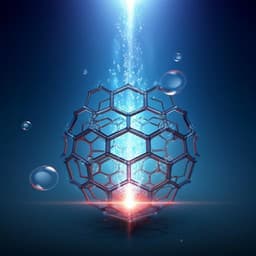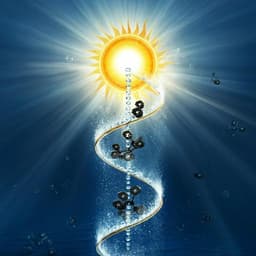
Chemistry
Breaking through water-splitting bottle-necks over carbon nitride with fluorination
J. Wu, Z. Liu, et al.
This groundbreaking research reveals how fluorination can enhance the water-splitting capabilities of graphitic carbon nitride (g-C3N4) by mitigating harmful C=O bonding. The findings demonstrate remarkably improved rates of hydrogen evolution and sustainable oxygen release, paving the way for advanced applications in energy conversion. Conducted by a team of skilled researchers including Ji Wu and Zhonghuan Liu.
~3 min • Beginner • English
Introduction
Producing hydrogen from water splitting using particulate photocatalysts is a low-cost, green approach for large-scale solar energy conversion. Graphitic carbon nitride (g-C3N4) can generate H2 under visible light when small organic hole scavengers are present and has suitable band positions (band gap >2.0 eV) to thermodynamically drive both HER and OER. However, single-phased pristine g-C3N4 generally fails to achieve overall water splitting from pure water due to insufficient OER activity, often attributed to weak oxidation capacity of valence band holes. Despite meeting band-edge requirements, continuous O2 evolution is not observed, implying an unidentified kinetic or surface-chemical bottleneck hindering OER. The study aims to uncover this bottleneck at the H2O/g-C3N4 interface and devise a strategy to bypass it to enable efficient overall water splitting under visible light.
Literature Review
Prior work shows g-C3N4 efficiently evolves H2 in the presence of organic hole scavengers and can achieve overall water splitting when combined with OER-active co-catalysts in heterojunctions (in-plane or Z-scheme). Single-phase g-C3N4 alone is widely considered incapable of overall water splitting due to inadequate OER activity. This inadequacy has been attributed to weak hole oxidation power, although g-C3N4 band positions satisfy thermodynamic requirements. Reports also show g-C3N4 is active for O2 reduction to H2O2, which can complicate O2 detection. The literature indicates morphological tuning and composite formation can enhance performance, but a fundamental understanding of the intrinsic OER limitation on pristine single-phase g-C3N4 remains lacking.
Methodology
- Catalyst synthesis: Pristine g-C3N4 (CN) was prepared by calcining melamine (10 g) at 550 °C for 4 h (5 °C min−1) in air, followed by acid washing (0.5 M HNO3, 80 °C, 4 h), washing, and drying. Fluorinated CN (F-CN) was synthesized by hydrothermal treatment: CN (1 g) dispersed in aqueous NaF (0.01–1 mM), pH adjusted to 3.5 (HClO4), sealed Teflon reactor at 180 °C for 12 h; samples denoted Fx-CN (x = NaF concentration). An exfoliated control (CN-E) was prepared identically without NaF.
- Structural and surface characterization: XRD for crystallinity; TEM for morphology; N2 adsorption-desorption for BET surface area; UV-Vis DRS for optical absorption; static and in situ DRIFTS (Thermo Nicolet iS10, MCT detector) to monitor interfacial species during illumination (420 nm LED, 3 W) with isotopic substitution (H2O vs H2 18O) to identify C=O formation; NAP-XPS (SPECS system, Al Kα) under 0.2 mbar H2O and white light (300 W Xe) to probe O1s/C1s/N1s evolution and detect C=O formation; XPS VB measurements; electrochemical impedance spectroscopy, photocurrent tests; electrochemical OER; HER and OER half-reactions with sacrificial agents (triethanolamine for HER, AgNO3 for OER).
- Photocatalytic testing: Overall water splitting in a top-irradiation Pyrex reactor (300 W Xe lamp, ≥300 nm, 1000 mW cm−2). Catalyst (30 mg) in 100 mL pure water; 3 wt% Pt loaded in situ via photodeposition (H2PtCl6). Gas evolution quantified by GC-TCD (Ar carrier, 5 Å sieve). Temperature 279 K, low vacuum. AM 1.5G simulated solar irradiation (including 3-sun conditions) used for comparative tests. Isotopic experiments employed D2O and H2 18O with GC-MS detection of D2 and 18O2.
- H2O2 quantification: Ce4+ back titration (absorbance at 316 nm) to determine H2O2 production rates.
- DFT calculations: Constructed F-CN by bonding a surface F atom to a CN surface C site; evaluated OER free-energy profiles at pH 7, U = 0 V vs SHE on CN C sites [CN(C)], CN N sites [CN(N)], and F-CN adjacent N sites [F-CN(N)]; analyzed charge density difference maps and PDOS (2p states) to elucidate bonding and electronic effects; explored effect of varying surface F coverage (1–8 atom%).
Key Findings
- In situ spectroscopic identification of bottleneck: DRIFTS under 420 nm illumination showed loss of O–H stretching (3700–3000 cm−1) and H2O bending (1645 cm−1), alongside a growing positive band at 1725 cm−1 assigned to C=O on pristine CN. With H2 18O, an isotope shift produced a new band at 1524 cm−1, confirming water as the O source for C=O. NAP-XPS under H2O vapor and white light revealed emergence of an O1s component at 532.7 eV (C=O) and C1s shifts toward higher binding energies, evidencing formation of oxidized carbon. These collectively indicate accumulation of C=O intermediates at the H2O/CN interface during OER.
- Fluorination suppresses C=O formation: F0.1-CN showed no C=O bands in DRIFTS with either H2O or H2 18O, and minimal changes in O1s/C1s in NAP-XPS during illumination, demonstrating that surface C–F bonding prevents carbon oxidation into C=O intermediates.
- Overall water-splitting performance: Under white light (Xe, >300 nm, ~1000 mW cm−2), pristine CN produced H2 at 12.51 µmol g−1 h−1 with no O2; CN-E produced 20.69 µmol g−1 h−1 H2 with no O2. Fluorinated samples exhibited both H2 and O2 evolution. F0.1-CN achieved H2 at 177.79 µmol g−1 h−1 (14.21× CN; 8.59× CN-E) and O2 at 46.47 µmol g−1 h−1. Under AM 1.5G (3 sun), F0.1-CN produced 83.89 µmol g−1 h−1 H2 and 21.15 µmol g−1 h−1 O2.
- Quantum efficiency and optics: Apparent quantum yields (AQY): at 365 nm, 0.5718% (F0.1-CN) vs 0.1281% (CN); at 420 nm, 0.0164% (F0.1-CN) vs 0.0005% (CN). UV-Vis DRS edges were similar between CN and F0.1-CN; higher F content slightly blue-shifted absorption.
- Selectivity and side reactions: H2/O2 ratios exceeded 2 (typically ~3–4) due to O2 reduction to H2O2 on CN surfaces. Measured H2O2 rates for F0.1-CN matched the O2 shortfall: 85.36 µmol g−1 h−1 (white light) and 41.75 µmol g−1 h−1 (AM 1.5G). Calculated STH efficiency (accounting for O2/H2O2) was 0.00195%.
- Stability: F0.1-CN maintained >70% of initial H2 and O2 rates over 40 h; CN and CN-E deactivated to <50% of initial H2 rate within 8 h, suggesting CN’s mild H2 came from unsustainable self-oxidation.
- Kinetics and charge: Transient PL showed slightly shorter exciton lifetime for F0.1-CN (τA 6.36 ns) vs CN (τA 7.72 ns), excluding lifetime extension as cause. XPS VB position was ~1.88 eV for both, excluding VB shift. Electrochemical tests showed reduced OER potential for F0.1-CN vs CN/CN-E; HER rates were similar, while OER half-reaction was significantly enhanced by fluorination.
- Effect of F content: Increasing F content (F/C from 0.6 to 11.4 atom%) did not change crystallinity or BET area, but slightly blue-shifted absorption, increased impedance, decreased photocurrent, reduced hydrophilicity (higher water contact angle), and accelerated sedimentation, increasing light transmittance through suspensions (30.03%→63.79%), collectively degrading activity at high F loadings.
- DFT mechanism: On pristine CN, the C site is the predominant OER site with high barriers (ΔG for *OH formation 2.25 eV; *O→*OOH 1.90 eV). After F occupies the C site, adjacent N becomes the active site with much lower barriers (0.86 eV for *OH formation; 1.58 eV for *O→*OOH). Charge density maps show optimized local charge redistribution at the N site in F-CN, avoiding excessively strong C–O or weak N–O interactions. PDOS indicates N 2p states shift upward toward the Fermi level upon F modification, increasing oxidizing ability and facilitating *OH bonding. Varying F coverage (1–8 atom%) did not significantly alter barriers per active N site; coverage affects the number of active sites.
Discussion
The study reveals that accumulation of strongly bound C=O intermediates at the H2O/CN interface is the hidden bottleneck that renders pristine single-phase g-C3N4 surfaces inert for OER, preventing continuous overall water splitting. In situ DRIFTS and NAP-XPS directly correlate C=O buildup with deactivation. Surface fluorination occupies carbon sites with C–F bonds, suppressing C=O formation and shifting OER activity to adjacent nitrogen sites, thereby lowering kinetic barriers and enabling sustained O2 evolution. Performance gains are not due to changes in morphology, crystallinity, optical absorption edge, exciton lifetime, or valence band position, but arise from altered surface reaction pathways and intermediates, as supported by electrochemistry and DFT. The mechanism clarifies why pristine CN, despite favorable band energetics, fails at OER: excessively stable *O in C=O form hinders progression to *OOH and O2. Fluorination both removes C as an OER site and electronically activates neighboring N, optimizing *OH and *OOH formation. The remaining deviation from stoichiometry (excess H2) stems from concurrent O2 reduction to H2O2, a known activity of CN, suggesting that product selectivity also governs observed gas ratios.
Conclusion
This work identifies and directly evidences C=O intermediate accumulation on pristine g-C3N4 as the core bottleneck that deactivates OER and prevents overall water splitting on single-phase CN. A simple surface fluorination strategy forms C–F bonds that suppress C=O formation and activate adjacent nitrogen sites as efficient OER centers, enabling visible-light-driven overall water splitting with order-of-magnitude higher H2 rates and continuous O2 evolution. DFT establishes reduced OER barriers at N sites in F-CN and provides an electronic rationale via N 2p state shifts. The findings provide a mechanistic foundation and a practical surface-chemistry route to unlock overall water splitting on metal-free CN photocatalysts. Future research could optimize F coverage to maximize active N sites while preserving dispersion, mitigate H2O2 side reactions to restore 2:1 H2/O2 stoichiometry (e.g., co-catalysts selective for OER and suppressing ORR), explore alternative halogenation or heteroatom strategies that similarly passivate C sites but enhance N-site activity, and integrate earth-abundant co-catalysts to improve efficiency and stability without noble metals.
Limitations
- The H2/O2 production ratio exceeds the stoichiometric 2:1 due to concurrent O2 reduction to H2O2; side reactions reduce O2 yield and overall solar-to-hydrogen efficiency (reported STH 0.00195%).
- High fluorine loadings degrade performance via increased charge-transfer resistance, reduced hydrophilicity and suspension stability (faster sedimentation), and diminished effective light absorption.
- Apparent quantum yields remain low in the visible region, and long-term stability, while improved, still shows ~30% performance loss over 40 h.
- Use of 3 wt% Pt co-catalyst may limit cost-effectiveness and scalability; performance without noble metals is not established.
- Experiments were conducted under controlled lab conditions (e.g., low vacuum, specific illumination intensities); scalability and performance under ambient, real-solar conditions require further validation.
Related Publications
Explore these studies to deepen your understanding of the subject.







